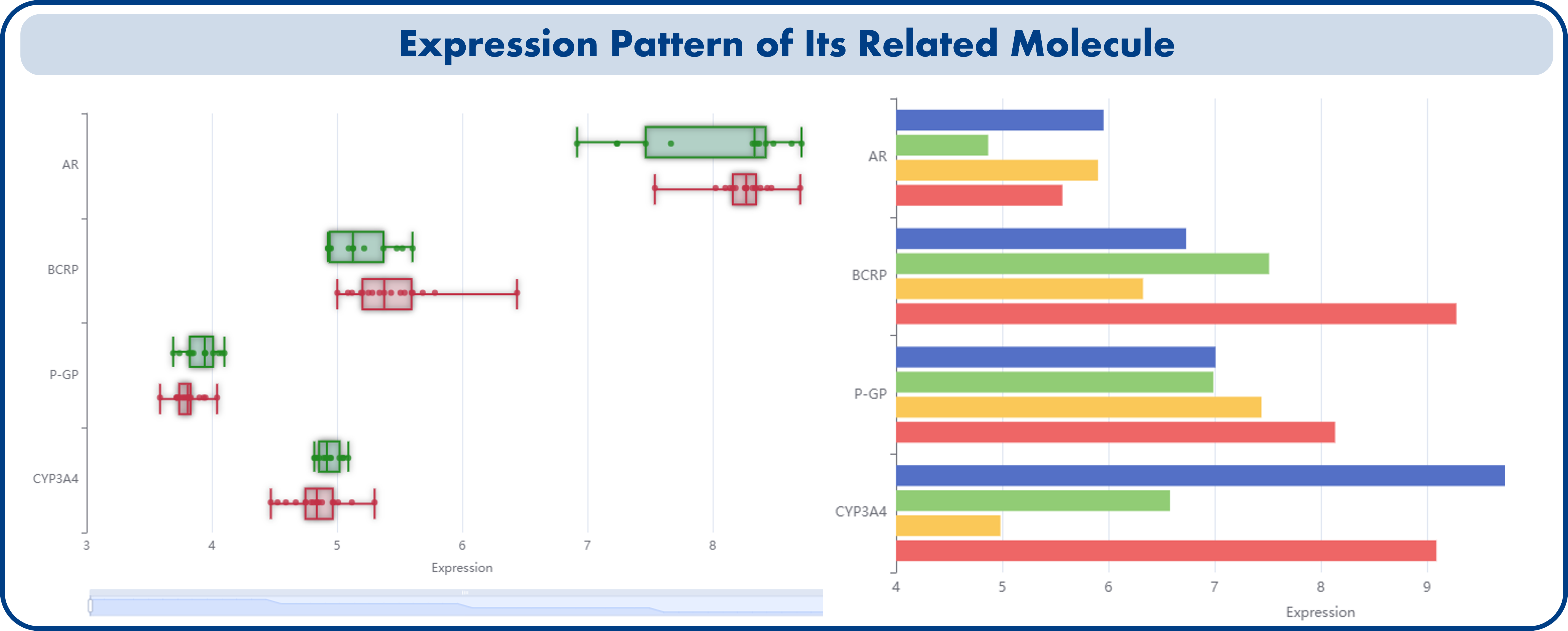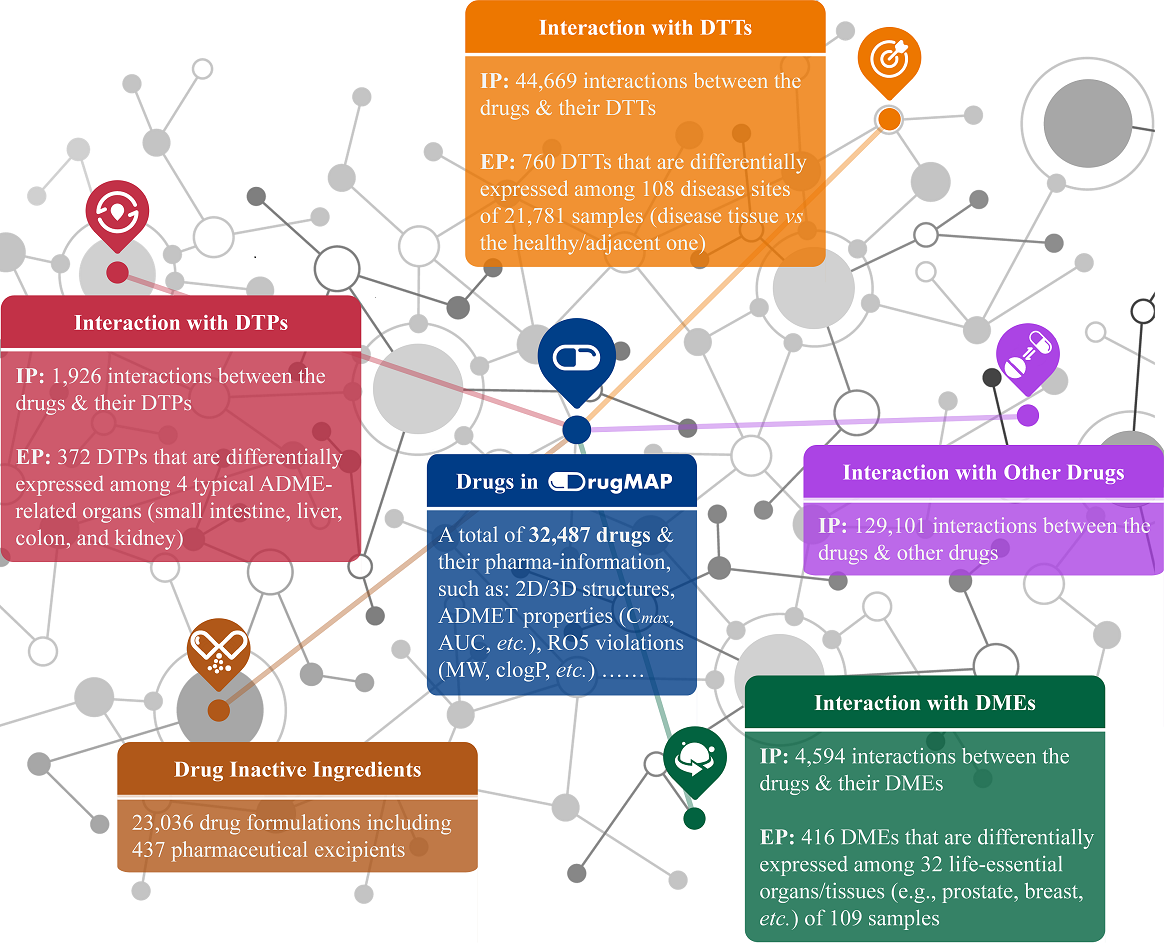DrugMAP: the Molecular Atlas and Pharma-Information of Drugs
The efficacy and safety of drugs are widely known as being determined by their interactions with many molecules of pharmacological importance (Genet Med. 2018; 20:622-629). For instance, drug’s therapeutic effect and resistant profile are largely shaped by its interaction with targets (Cancer Cell. 2020; 38:31-43); the absorption, disposition and elimination of drugs are substantially affected by their interaction with channels/transporters (Nat Rev Drug Discov. 2015; 14:29-44); drug metabolism and prodrug’s biosynthesis are greatly regulated by the corresponding enzymatic interactions (Pharmacol Ther. 2019; 201:137-180); and so on. In other words, the efficacy and safety of a drug come from the collective regulation by many molecules of an extremely sophisticated mechanism.

DrugMAP: Molecular Atlas and Pharma-information of drugs, is therefore introduced. First, a comprehensive literature review on ~3,000 approved drugs, ~12,000 drugs ever tested in clinical trial, ~6,000 patented/preclinical drugs and ~20,000 investigative agents, was conducted. Second, interacting molecules of pharmacological importance to all these drugs were systematically collected, and a total of 5,067 molecules were identified to lead to certain pharmacological effects (related to 624 disease classes as defined in the WHO ICD-11 (Lancet. 2019; 393:2275)) by interacting with 32,487 drugs. The structures of 26,286 drugs (~81.0%) and 4,858 molecules (~95.9%, the majority of which were generated using AlphaFold (Nature. 2021; 596:583-589)) were also provided in DrugMAP. Third, the expression patterns of 1,539 molecules among 108 disease sites of 21,781 patients, 1,323 molecules among 4 typical ADME-related organs (small intestine, liver, colon, kidney) of 236 health individuals, and 1,286 molecules among 32 physiological/life-essential site/organ (e.g., prostate, breast, etc.) of 109 samples, were systematically collected and explicitly described in DrugMAP. Finally, a comprehensive and precise ‘network’ that contained 50,180 drug-molecule interactions was constructed. The subnetwork for each drug and the entire network for all drugs were made freely accessible, which could be readily visualized by directly loading those downloaded network files to Cytoscape

All in all, DrugMAP is UNIQUE in (a) providing the comprehensive set of interacting molecules of pharmacological importance for >30,000 drugs, (b) demonstrating the differentially expressed patterns of those interacting molecules among different disease sites, ADME-related organs, and other physiological/life-essential sites, and (c) describing, for the first time, a comprehensive and precise network containing >50,000 drug-molecule interactions. Due to the rapid advances in AI technology and complex network analysis, DrugMAP is expected to have great implications and impact on current drug discovery. So far, it has been smoothly running for months, and tested by several independent research groups from different sites around the world, including United State, United Kingdom, Germany, Singapore and China. All data are now fully accessible, and will be completely downloadable once it is accepted for publication. DrugMAP is now freely accessible without any login requirement by all users.

Data Statistics for Latest Release
The latest release of DrugMAP was released on July 20, 2022. The detailed Data Statistics is as follows:
In the latest version of DrugMAP, a total of ~33,000 drug/drug candidates entities of clinical importance were stored, and their general information (name, synonyms, indications, therapeutic class, etc.) was also extracted. Particularly, ~700 diseases corresponding to the indications of drugs were manually checked and mapped to the International Classification of Diseases (ICD-11). Moreover, the 2D and 3D structures of ~26,000 drugs (~81.0%) were made visualizable and fully downloadable (in SDF file) from the online database.
Moreover, 44,669 pharmacodynamic-related interactions between 32,148 drugs and 3,095 DTTs, and 6,520 drug ADME-related interactions between 2,194 drugs and 1,118 DTPs and DMEs were identified and made available in DrugMAP. Overall, a total of 5,067 molecules were collected that exhibited some pharmacological effect through interactions with 32,487 drugs associated with the 624 disease categories defined by ICD-11.
In addition to the interaction data described above, DrugMAP collected information on drug-drug interactions (DDIs) and drug-inactive ingredients (DIGs). Information was collected on 23,036 formulations of 1020 drugs (containing a total of 437 unique DIGs), identifying approximately 130,000 clinically reported DDIs resulting from co-administration of therapeutic agents in 1344 drugs approved or in clinical trials.
The expression patterns of 1,539 molecules from 108 disease sites in 21,781 patients, 1,323 molecules from 4 typical ADME-related organs (liver, colon, kidney and small intestine) in 236 healthy individuals, and 1,286 molecules from 32 physiological organs (prostate, breast, etc.) in 109 samples were systematically collected and then made available to the DrugMAP database. All these molecules are described in this database as interacting with at least one drug.

